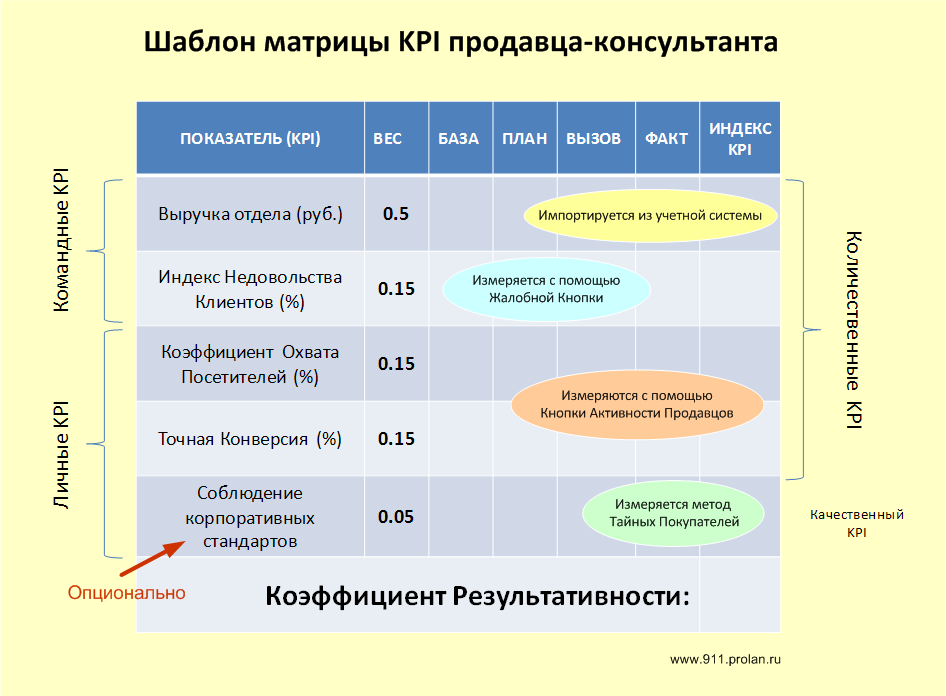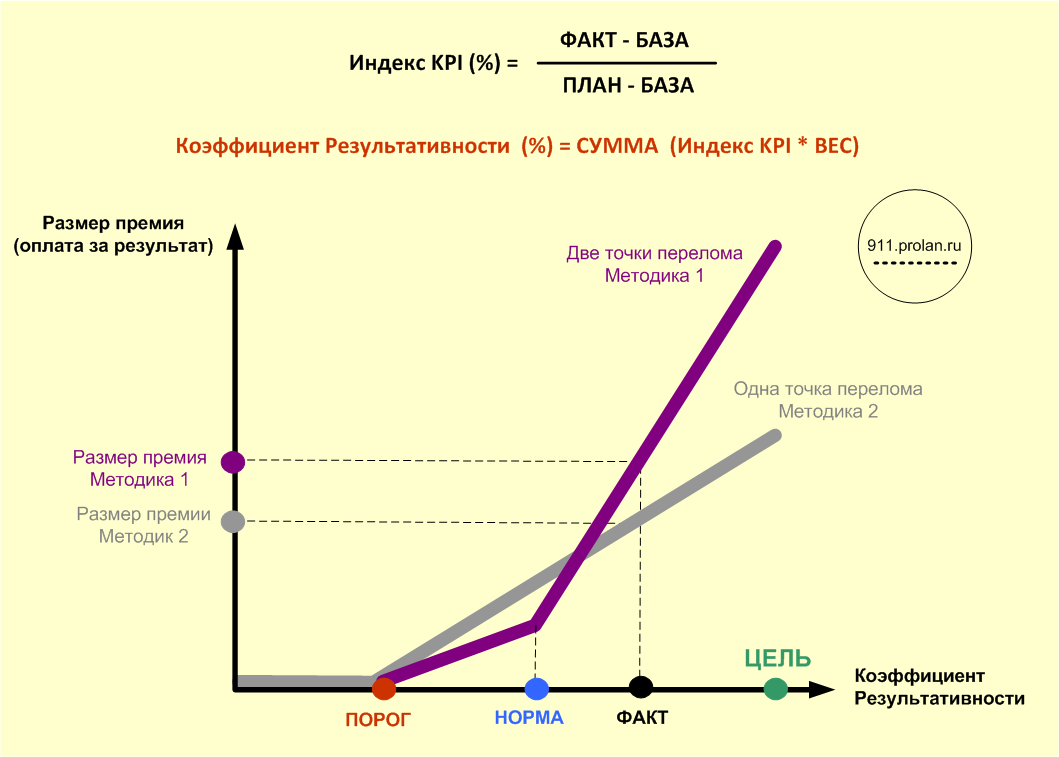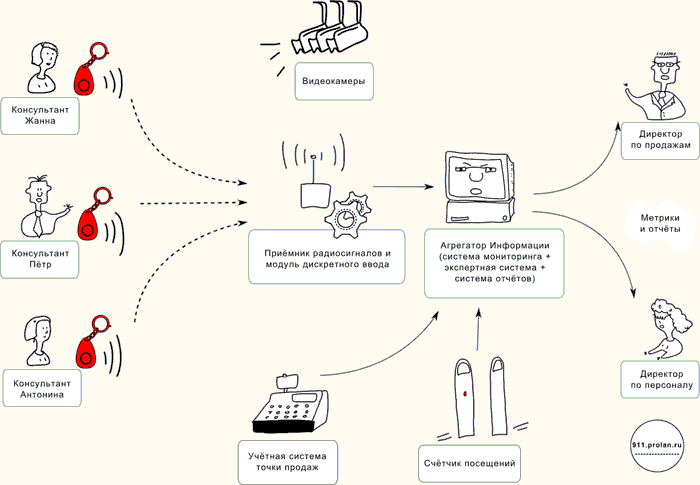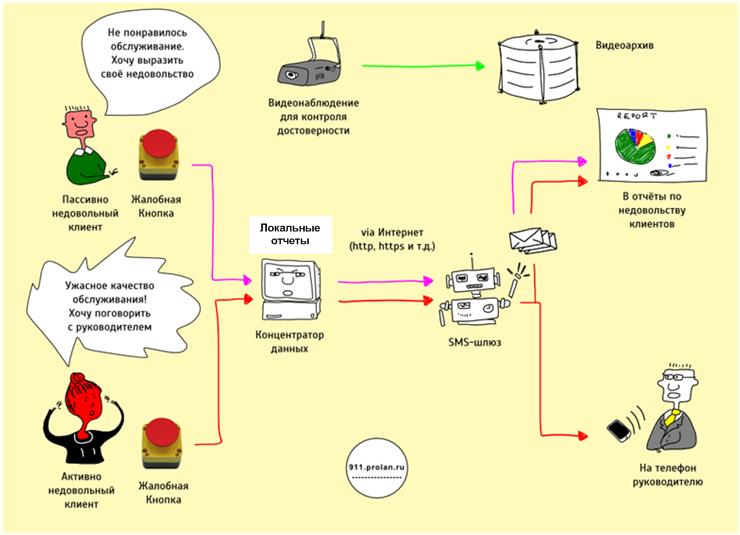Performance management of sales assistants. KPI Matrix

Most often, the performance of sellers is estimated only by sales. Therefore, the seller’s salary is usually composed of a salary and a bonus depending on revenue. Despite the widespread use of this scheme, it has several important drawbacks. The first and main drawback, it motivates sellers to use all available opportunities to increase sales. Second, it does not motivate sellers to increase loyalty and quality customer service. Third - it practically does not motivate sellers to increase their professional level. In this article I will talk about a balanced matrix of indicators (KPI), which allows not only to effectively manage sales, but also to achieve other important goals - to increase customer loyalty, to provide training and development of personnel.
Ask what it has to do with IT? The most immediate. The success of KPI management depends not only on WHAT is measured, but also HOW it is done. Qualitative (not quantitative) KPI, based on the subjective assessment of the manager and manual input of the results, have “buried” more than one KPI implementation project. The simplicity and manufacturability of measuring KPIs are absolutely necessary conditions for success, and they are ensured only by the introduction of IT. Today, IT in retail is, as a rule, only cash and accounting systems. The only indicator (KPI) that they allow to receive automatically is revenue. Therefore, vendor performance management most often comes down to uploading revenue information to MS Excel.
But it is possible in another way, and it practically does not require expenses. Any IT company (IT service) in the arsenal has many systems that can be effectively used in retail. Service Desk products can be used to manage claims. Network management systems can be used to monitor KPIs, etc. But to use such tools, you need to understand what the business needs. This article is about this, so first a bit of theory.
')
KPI Management

Figure 1. Sales Consultant KPI Matrix Template
KPI management begins with the creation of a KPI (goal agreement) matrix. This is a table (see Figure 1), including personal and team, qualitative and quantitative performance indicators. For each KPI, it is necessary to establish, firstly, the WEIGHT depending on the current priorities of the company (the sum of the weights of all indicators must be equal to 1), secondly, three threshold values characterizing the employee’s tasks for the upcoming period:
- BASE is the worst acceptable KPI value. This is the “zero” point from which the employee’s performance is counted. If the KPI value is lower than the BASE, then the seller does not match the position held.
- PLAN - this is what must be carried out for the company to achieve its goals.
- CALL is the maximum possible KPI value. If the FACT value is higher than the CALL value, then when calculating the KPI Index, the CALL value is substituted for the FACT value. Otherwise, in case of an error in the PLAN installation, it may turn out that it is completed by 1000%.
After a reporting period of time, for example, a month, it is necessary to evaluate the performance of each employee. For this, for each indicator you need to measure its actual value (FACT). Then, based on the values of FACT, BASE, PLAN, CALL, using the formulas below, the Employee Productivity Ratio is calculated.

Figure 2. The calculation of the Coefficient of Efficiency and the method of calculating the award.
The efficiency coefficient is used to determine the variable part of the remuneration (bonus). For this, a method should be chosen that determines the dependence of the award on the Efficiency Coefficient. This dependence can be linear or nonlinear, the dependence curve can have one or two break points. In this case, the rule is usually observed that premiums are accrued only if the Coefficient of Efficiency exceeds a certain threshold value (THRESHOLD), for example, 85%.
Thus, KPI management provides businesses with at least four effective personnel management levers, namely:
- Matrix-based indicators (KPI);
- KPI weights;
- KPI thresholds (BASE, PLAN, CALL)
- The method of calculating the premium depending on the values of the Coefficient of Efficiency and its threshold values: THRESHOLD, NORM, AIM.
But for the levers to work, a number of conditions must be met. The set of indicators must be balanced. Measurement of indicators should be technologically advanced. The business needs to know how to determine threshold values for indicators. The reliability of the results should not cause doubts neither in business nor in workers. In retail, in my opinion, these requirements are met by the set of indicators shown in Table 1.
| Indicator | Tactical mission | Strategic goal | |
|---|---|---|---|
| one. | Revenue department (rub) | Motivation of sellers to increase the size of the check and the number of positions in the check | Increase market share |
| 2 | Accurate Conversion (%) | Motivation of sellers to improve the quality of sales attempts (try to turn each visitor into a buyer) | |
| 3 | Visitor Coverage Ratio (%) | Motivation of sellers to increase the number of sales attempts (to approach every visitor to the point of sale) | |
| four. | Customer Grievance Index (%) | Motivation of sellers to increase customer satisfaction from the purchase | Increase customer loyalty |
| five. | Compliance with corporate standards (optional) | Motivation of sellers to increase their professional level | Staff training and development |
Department revenue
The revenue of a department is the amount of revenue in money terms from the sale of goods minus value added tax, excise taxes and other obligatory payments. I believe that it is the command indicator (total revenue of the department) that needs to be included in the KPI matrix, since This improves the psychological climate in the team.
Department revenue measurement can be performed automatically. To do this, it is enough to develop a software module that imports (or uploads) relevant data from the accounting or cash system to the KPI monitoring system. Usually, the development of such a module takes several hours of programmer work.
The weight of this indicator depends on the current priorities of the company. I think that for most companies the value of 0.5 will be optimal. The revenue of the department is the only indicator (from those considered in this article) characterizing the Result. All other indicators characterize the process. Stable to achieve the desired results is possible only with the proper organization of the Process. Therefore, the weight of the indicator characterizing the Result should be equal to the total weight of the indicators characterizing the Process.
Usually, the determination of threshold values for a department’s revenue is made on the basis of an analysis of data obtained in the previous period. For this, it is necessary to analyze not only the previous revenue of the department , but also HOW it was received. For this you need to analyze the indicators characterizing the process. For example, if in the previous period Exact Conversion and Visitor Coverage Ratio were low, and therefore you developed new scripts and conducted personnel training, then in the next period it is advisable to set higher thresholds for department revenue .
Accurate Conversion, Visitor Coverage Ratio

Figure 3. Accurate Conversion Measurement and Visitor Coverage Ratio.
Exact Conversion (TK) is the percentage ratio of the number of sales to the number of sales attempts (the number of consultations, fittings, etc.). This indicator characterizes, first of all, the professionalism of the seller.
Visitor Coverage Ratio (CPC) is the percentage ratio of sales attempts to department visitors. This indicator characterizes the activity of the seller and, in part, its compliance with corporate standards. For example, in many companies there is a rule that the seller must contact the incoming buyer no later than one minute after the appearance of the one in the department.
TC and CPC are complementary indicators, whose weights should be the same (explanation below). At the same time, the sum of their weights should exceed the weight of any other indicator characterizing the Process. This is due to the importance of tactical tasks for which they are used. I think the weight of 0.15 for each of them is optimal. Both of these indicators are categorized as personal quantitative KPIs. The calculation of these indicators is performed by the KPI monitoring system automatically. The metrics used to calculate TC and CPC can be obtained as follows:
- The number of sales (as well as the revenue of the department) is automatically imported from the accounting or cash system.
- The number of visitors is measured using a visitor counter, which is usually set at the entrance to a sales point. The resulting values are automatically recorded in the KPI monitoring system database using a special software module. The main thing is that the meter used allows you to connect it to a computer. Therefore, when choosing a counter model, you should choose models that allow it.
- The number of sales attempts is measured using the Sellers Activity Button solution. Briefly, the essence of this decision is that each seller receives a wireless key-ring (the Seller's Button), which he must press every time he tries to sell (for example, he advises the buyer). Information on the number of clicks (sales attempts) is automatically recorded in the database of the KPI monitoring system.
It is often asked how to determine the share of visitors of each department, if at the point of sale only one visitor counter is used, which is installed at the entrance to the store? The problem is solved by conducting a simple study. At each time, for the time of the survey, a specialist-surveyor is attached, who, using the button of the Seller, fixes each customer who enters the department. Information on the number of clicks on the Seller’s Button and information on the number of visitors, measured by the visitors counter, is automatically imported into a single KPI monitoring system database. At the end of the measurement, the ratio of the number of visitors to each department to the total number of visitors to the store is taken; the resulting value is multiplied by 100%. Thus, the “popularity” is determined as a percentage of each department of the store. Such measurements should be carried out ~ 1-2 times a year or after making significant changes at the point of sale. The duration of each measurement should be determined depending on the number of visitors, and should be such that the total number of measurements is at least 100. Let me give an example. Suppose that during the measurement, a store consisting of two departments entered 100 people (the minimum number of measurements required). At the same time, 85 people approached the first department, and 90 people approached the second. This will mean that the popularity of the first department is 85%, the second - 90%. Thus, if on some day 200 people enter the store (this will be measured by the visitors counter), then we will assume that 170 people approached the first department (200 * 0.85) and 180 people (200 * 0.9) went to the second department . If there are several sellers in each department, the number of visitors per seller is determined in proportion to the time worked by each seller. Agree that it is interesting to determine the “popularity” of each department and without implementing KPI.
It is also often asked how to make sure that the sellers do not make false clicks of the Seller’s button or, on the contrary, do not underestimate the number of clicks? You can control the accuracy of the number of clicks using the technology of Expert Monitoring based on video surveillance. But in most cases, you can do without the use of expert monitoring. The number of sales attempts is used in calculating both TC and CPC. In this case, in the formula for calculating the TC, the number of sales attempts is in the denominator, and in calculating the CPC - in the numerator. If the weights of these indicators are the same, then the seller does not have any sense to overstate or underestimate the number of sales attempts. By improving one indicator, it will automatically worsen the other.
Determining the threshold values of the CPC is usually not difficult. With an adequate number of sellers, all threshold values should not vary greatly and should be close to 100%. If you are not sure that the number of sellers is sufficient, analyze the actual CPC values. If you see that at certain periods of time, the CPC is significantly lower than 100%, then it makes sense to think about increasing the number of sellers.
Determining the threshold values of TC is a more difficult, but also solvable problem. To do this, you need to analyze historical data or find out the average value of TC in your segment and region. If the TC in your company (or a specific point of sale) is lower than that of competitors, use the services of Mystery Shoppers.
Customer Grievance Index

Figure 4. Measuring Customer Grievances Index.
The Customer Grievance Index (INC) is a quantitative command indicator that characterizes customer satisfaction with the quality of service. The lower the INC, the higher the customer satisfaction.
The INC is the percentage ratio of the number of buyers who expressed their dissatisfaction with the quality of service to the total number of visitors to the department. The number of visitors is measured using the counter of the number of visitors and the methodology outlined above. To measure the number of customers who are dissatisfied with the quality of service, the Complaint Button solution is used. Briefly the idea of the Complaining Button is as follows.
In each department of the point of sale there is a big red button and a sign similar to the following:
Dear customer!
Thank you for choosing our store. We strive to constantly improve the quality of service, so we will hear with great gratitude any comments and suggestions.
If the quality of service does not meet your expectations, please press this button once.
If you want to report your remarks personally to the store director, please press the call button and hold it for about 3 seconds.
Each button press is automatically recorded and recorded in the KPI monitoring system database. If the buyer not only pressed the red button, but also held it for ~ 3 seconds, then the administrator or claim manager will also receive an sms-message with information about when and in which department the button was pressed. Next to the button is a video camera that records a picture and a voice to the archive.
Each push by the buyer of the red button should be checked for fairness. For this, a special KPI monitoring system console is used. When calculating the actual value of the INK, you should use only proven keystrokes qualified as fair.
KPI monitoring system supports two types of clicks - short and long. This is done to distinguish between passive and active customer dissatisfaction. For example, if the buyer was not noticed, and leaving the department, he pressed the red button, then this is passive discontent. If the seller is rude to the buyer or was trying to deceive him and the buyer wants to inform the store director, then this is already an active discontent. Obviously, the weight of active discontent should be higher. But in order not to introduce an additional line in the KPI matrix, we offer active discontent with a multiplying factor to recalculate into passive discontent. For example, each case of active dissatisfaction in the calculation of the INC may amount to five or ten cases of passive discontent.
To determine the threshold values of the INC, it is sufficient to collect and statistically process historical data. The number of buyers who are always unhappy, regardless of the quality of service, for each region, as a rule, constantly.
Compliance with corporate standards
Verification of compliance by vendors with corporate standards is a mandatory element of the system of customer service quality management. Such verification is usually performed by the Mystery Shoppers method. Most often, these are specially trained people who, under the guise of ordinary buyers, come to the point of sale and, according to a specific program (check list), check the work of sellers. Obtained in this way, the results are important for the diagnosis of low efficiency sellers. But as to whether or not to include the results of Mystery Shoppers in the KPI matrix, I do not have a definite answer.
Arguments for inclusion in the KPI matrix:
- The observance of corporate standards by sellers is one of the criteria for their professionalism, and I don’t know another effective way to check this, apart from using Mystery Shoppers.
- The results obtained by the method of Mystery Shoppers are used not only to assess the performance of sellers, but also to solve other problems. Therefore, many companies do it anyway. If so, then why not use the information received also to assess the performance of sellers.
Arguments against inclusion in the KPI matrix:
- Most companies invite Mystery Shoppers no more than once a quarter, and it is advisable to do an assessment of vendor performance on a monthly basis.
- This is the only qualitative indicator that requires manual data entry and is characterized by low sample reliability and uncertain reliability of results. In addition, each arrival of Mystery Shoppers is a stress for sellers, which can negatively influence the psychological climate in the team. For details, see " Secret Buyers. Need a restructuring? "
Given the above arguments, I propose the following solution. If the company regularly uses the services of Mystery Shoppers, then this indicator with a weight of 0.05 is included in the KPI matrix. If the company does not use the services of Mystery Shoppers or does it irregularly, then this indicator should not be included in the KPI matrix. In the second case, the released weight of 0.05 should be added to the weight of the Clients Grievance Index c .
Vasya, Masha, KPI and Information Technologies
In the figure at the beginning of the article, Vasya and Masha demonstrate two approaches to organizing sales. Vasya is a supporter of the market approach - sales at any cost, the end justifies the means. Masha prefers to work according to the rules - to achieve the desired Result, you need to properly organize the process. This is the KPI control. Both the first and second approaches have advantages and disadvantages. Obviously, the first approach is simpler and cheaper to implement. But he has an important and not all understandable flaw. In order to work effectively, it is desirable that the sellers were stars . People who can and want to be stars , unfortunately, not very much. A mature business has long understood this, and therefore implements KPI management. Ultimately, it is more profitable, because allows you to achieve the desired result without stars . They are replaced by technology.
However, KPI control technology has not only supporters, but also opponents. KPI control can be compared to drilling holes in concrete. If you only have a hand drill, then drilling holes is a headache. It is easier to prove that the holes are generally not needed or even harmful. If you have a powerful punch, then drilling holes is not only not a problem, but also a pleasure. As you probably guessed, Information Technologies are such a “perforator”.
Russia's economy from stagnation turned into a recession. Therefore, in order to "survive", IT service is not in words, but in practice must become a profit center. I want to believe that this article will tell someone how to do it.
Source: https://habr.com/ru/post/214619/
All Articles